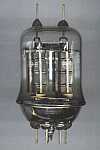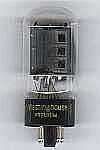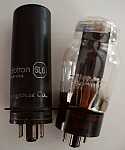
|
807
This is probably the best-known classic transmitting tube. It's been dubbed
"The valve that won the war" because of its extensive use by the Allied
forces during WWII. Still a favourite amongst both RF and audio enthusiasts.
|
|
811A
Along similar lines is this gorgeous high-power triode. Notice the
particularly buxom ST (coke-bottle) envelope, which allows it to operate at
temperatures that would melt ordinary valves. In ICAS service it's normal for
its anode to glow dull red.
|

|
|

|
2E26
This little tube is an example of the care in craftsmanship employed in
vintage valves. It's a small power tetrode capable of operating well into the VHF
region, and was a staple in early VHF FM tranceivers.
|
|
6146
This can be viewed as a "big brother" to the 2E26, and enjoyed
immense popularity as an output driver for shortwave to low-VHF transmitters. CB
footwarmers, anyone? Like most of the devices on this page, it's also a great
audio tube.
|

|
|

|
829B
Here's one that could be viewed as a "dual 807" in terms of its
power capability. Notice the all-glass, baseless construction, and the impeccable
glass weld at the seam. Stunning in real life, the pic really doesn't quite capture it.
|
|
QQV06-40A
Here's the European take on the dual high-frequency tetrode. It's hard to
imagine a more elegant and efficient design; the valve has a single cathode and screen,
split grids and plates, and even sports built-in neutralizing capacitors. Or have a look at a
3D pic of this valve.
|

|
|

|
TT15/CV415
Another lovely military dual beam tube, with an aluminum 9-pin locking base
(similar to loktal). It can be thought of as along the lines of a dual 6V6, and features
a unique square- shouldered, extra thick glass envelope. You could drive nails with this
critter.
|
|
828
They don't build 'em like this anymore, and there aren't very many 828's still
in existence. The 12AX7 in the second pic gives an idea of its size. Note the unusual
straight- sided variation on the ST package.
|

|

|
|

|
6AV5GT
Beauty is not the sole domain of transmitting and military tubes. It's hard to
beat the elegance of many of the devices used in television and other consumer gear, such
as this pretty deflection and regulator tube.
|
|
6CB6A
Another of my favourite receiving tubes is the lovely little 6CB6A. Its
cutaway anode and internal shield allows a full view of the entire grid and cathode
structures. Again, a 2-D picture only gives a hint of the marvel of engineering that these
remarkable devices really are.
|

|
|

|
Two 6L6's
Here's a time-trippy little picture of two 6L6's; the original American metal
tube, next to a Chinese 6L6GC made in the Shuguang factory probably in the 1980's.
|
|
6J10
The valve's last stand against the rapidly evolving transistor was dubbed the
"Compactron". This one contains a pentode and a beam tube in an envelope about
the height of a 12AX7. It's staggering to imagine the tooling required to produce these
gizmos.
|

|
|












